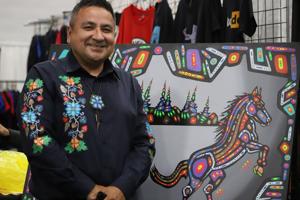Education
Gwich’in Teachings Illuminate Path to Truth and Reconciliation

In the early 1920s, a significant moment unfolded on the banks of the Peel River near Fort McPherson in the Northwest Territories. Families from the Dinjii Zhuh (Gwich’in) community gathered in profound grief as Anglican missionaries loaded children, some as young as two years old, onto boats bound for the St. Peter’s Indian Residential School in Hay River, nearly 2,000 kilometres away. This painful chapter of history is vividly recalled by Gwich’in Elder Mary Effie Snowshoe, who describes it as a “sad story” passed down through generations. Central to this narrative was Chief Julius Salu, who, having lost his daughter to the residential school system earlier that year, declared, “No more. Nobody is to send their children away again.”
Chief Salu’s proclamation was not just an act of defiance; it reflected the principle of guut’àii, a Gwich’in term signifying “acting with one mind.” This principle embodies the collective strength and governance that guided Gwich’in families through the traumatic era of residential schools. Today, as denialism regarding these institutions gains traction in Canada, the teachings of guut’àii offer vital lessons in resisting such narratives.
Strength in Context: The Impact of Distance and Community
In her book, By Strength, We Are Still Here: Indigenous Peoples and Indian Residential Schooling in Inuvik, Northwest Territories, the author emphasizes that the concept of strength transcends individual resilience. Instead, it is rooted in kinship, collective responsibility, and ancestral knowledge. The experiences of children in northern residential schools like Grollier and Stringer Halls illustrate the complexities of this strength. Many children traveled vast distances, often thousands of kilometres, fostering a sense of solidarity through shared adversity.
The diverse student body included Dinjii Zhuh, Inuvialuit, Métis, Inuit, Sahtú, Dënesųłįne, Tłı̨chǫ, Cree, and others, which led to alliances that later fueled pan-Indigenous political movements in the 1970s. Memoirs by survivors such as Stephen Kakfwi and Antoine Mountain highlight these connections, illustrating how cross-cultural solidarity emerged amidst the backdrop of oppression.
Recognizing Genocide and Resisting Denialism
Residential schools were not mere misguided institutions; they were designed to dismantle Indigenous families and governance structures. The United Nations defines genocide as the “forcibly transferring children of the group to another group,” a definition that aligns with the historical realities of Canadian Indian residential schools. Survivor testimonies collected by the Truth and Reconciliation Commission (TRC) provide compelling evidence of both the harm inflicted and the resilience displayed by Indigenous Peoples.
Despite overwhelming documentation, residential school denialism is increasingly common in public discourse. As noted by historian Sean Carleton and anthropology graduate student Benjamin Kucher, denialists undermine Indigenous testimonies, claiming the schools were not as harmful as portrayed or that survivors exaggerate their experiences. In this context, the Gwich’in teachings of strength become crucial for countering such narratives.
By reframing survivors as advocates of governance and solidarity, the principle of guut’àii emphasizes that agency exists even under duress. Acts of solidarity within these oppressive institutions do not absolve them of responsibility; rather, they highlight the courage of Indigenous Peoples in resisting attempts at cultural destruction.
Denialism has tangible consequences, especially for families still searching for missing children. Calls for “proof” through exhumations dismiss the extensive evidence already available and pressure communities to act rapidly and unsafely. Surveys reveal a concerning knowledge gap among Canadians regarding residential schools. A 2024 Ipsos poll found that while 75 percent of Canadians believe governments should acknowledge this legacy more, many lack a deep understanding of the issues at stake.
Path Forward: Confronting Denialism with Collective Strength
Confronting denialism through guut’àii means centering the voices of survivors and supporting families with the necessary resources and time. It requires an acknowledgment that Indigenous strength is not solely about survival; it also encompasses structural transformation. Children who survived residential schools often went on to lead fulfilling lives and successful careers, not due to the system, but because of Indigenous resilience and community support.
As the author prepares to release a forthcoming book with anthropologist Sara Komarnisky, titled Talk Treaty to Me: Understanding the Basics of Treaties and Land in Canada, the focus remains on the collective responsibilities embedded in treaties. These agreements, much like guut’àii, emphasize commitments made “with one mind,” which are essential for shaping a shared future.
Chief Salu’s promise to stand for his people serves as a powerful reminder that the history of residential schools encompasses both profound harm and remarkable strength. By standing alongside survivors, fostering Indigenous-led truth-telling, and firmly rejecting denialism, Canadians can ensure that the nation’s future is grounded in honesty, justice, and respect. The journey towards reconciliation is not just about survival; it is about transforming oppression into collective action and confronting denialism with unwavering resolve.
-

 World3 months ago
World3 months agoScientists Unearth Ancient Antarctic Ice to Unlock Climate Secrets
-

 Entertainment3 months ago
Entertainment3 months agoTrump and McCormick to Announce $70 Billion Energy Investments
-

 Science3 months ago
Science3 months agoFour Astronauts Return to Earth After International Space Station Mission
-

 Lifestyle3 months ago
Lifestyle3 months agoTransLink Launches Food Truck Program to Boost Revenue in Vancouver
-

 Technology2 months ago
Technology2 months agoApple Notes Enhances Functionality with Markdown Support in macOS 26
-

 Top Stories1 week ago
Top Stories1 week agoUrgent Update: Fatal Crash on Highway 99 Claims Life of Pitt Meadows Man
-

 Sports3 months ago
Sports3 months agoSearch Underway for Missing Hunter Amid Hokkaido Bear Emergency
-

 Politics2 months ago
Politics2 months agoUkrainian Tennis Star Elina Svitolina Faces Death Threats Online
-

 Technology3 months ago
Technology3 months agoFrosthaven Launches Early Access on July 31, 2025
-

 Politics3 months ago
Politics3 months agoCarney Engages First Nations Leaders at Development Law Summit
-

 Entertainment3 months ago
Entertainment3 months agoCalgary Theatre Troupe Revives Magic at Winnipeg Fringe Festival
-

 Politics1 week ago
Politics1 week agoShutdown Reflects Democratic Struggles Amid Economic Concerns




















